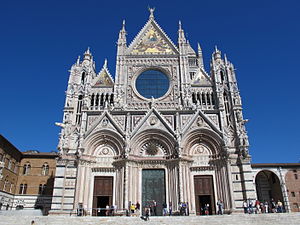Duomo in Siena
| Metropolitan Cathedral of Saint Mary of the Assumption Cattedrale Metropolitana di Santa Maria Assunta (Italian) |
|
|---|---|

Siena Cathedral
|
|
| Basic information | |
| Location | Siena, Italy |
| Geographic coordinates | 43°19′04″N 11°19′44″E / 43.3177°N 11.3290°ECoordinates: 43°19′04″N 11°19′44″E / 43.3177°N 11.3290°E |
| Affiliation | Roman Catholic |
| Province | Archdiocese of Siena-Colle di Val d'Elsa-Montalcino |
| Region | Tuscany |
| Year consecrated | c. 1215 |
| Ecclesiastical or organizational status | Cathedral |
| Status | Active |
| Architectural description | |
| Architect(s) | Giovanni di Agostino |
| Architectural type | Church |
| Architectural style | Italian Gothic, Romanesque, Classical |
| Groundbreaking | 1196 |
| Completed | 1348 |
| Specifications | |
| Direction of façade | West |
| Length | 89.4m |
| Height (max) | 77m |
| Dome(s) | 1 |
Siena Cathedral (Italian: Duomo di Siena) is a medieval church in Siena, Italy, dedicated from its earliest days as a Roman Catholic Marian church, and now dedicated to the Assumption of Mary.
Previously the episcopal seat of the Diocese of Siena, from the 15th century the Archdiocese of Siena, it is now that of the Archdiocese of Siena-Colle di Val d'Elsa-Montalcino.
The cathedral itself was originally designed and completed between 1215 and 1263 on the site of an earlier structure. It has the form of a Latin cross with a slightly projecting transept, a dome and a bell tower. The dome rises from a hexagonal base with supporting columns. The lantern atop the dome was added by Gian Lorenzo Bernini. The nave is separated from the two aisles by semicircular arches. The exterior and interior are constructed of white and greenish-black marble in alternating stripes, with addition of red marble on the façade. Black and white are the symbolic colors of Siena, etiologically linked to black and white horses of the legendary city's founders, Senius and Aschius.
The origins of the first structure are obscure and shrouded in legend. There was a 9th-century church with bishop's palace at the present location. In December 1058 a synod was held in this church resulting in the election of pope Nicholas II and the deposition of the antipope Benedict X.
In 1196 the cathedral masons’ guild, the Opera di Santa Maria, was put in charge of the construction of a new cathedral. Works were started with the north - south transept and it was planned to add the main, larger body of the cathedral later, but this enlargement was never accomplished.
By 1215 there were already daily masses said in the new church. There are records from 1226 onwards of the transport of black and white marble, probably for the construction of the façade and the bell tower. The vaults and the transept were constructed in 1259-1260. In 1259 Manuello di Ranieri and his son Parri carved some wooden choir stalls, which were replaced about 100 years later and have now disappeared. In 1264, Rosso Padellaio was paid for the copper sphere on top of the dome.
...
Wikipedia
